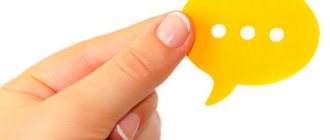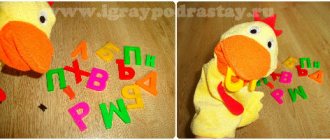“Methods of studying speech. Psychosemantic techniques".
Kornilova T.V.
K 67 Experimental psychology: Theory and methods: Textbook for universities. – M.: Aspect Press, 2002. – 381 p.
- Luria A.R. The role of speech in the mental development of a child // Questions of psychology. - 1958. - No. 5
Introduction.
The phenomena of speech and communication have not yet found a justified place in psychology textbooks. For many years, the topic “Speech” was presented in the system of cognitive processes following the topic “Thinking”. This logic made speech dependent on thinking, and the status of a “form of thought” was central to the interpretation of speech for a long time. In accordance with the current program, speech is analyzed as one of the means of communication. The topic precedes the analysis of cognitive activity and is therefore divorced from it. Difficulties in determining the place of speech in the system of psychology are not accidental. The phenomenon itself is extremely complex. The fundamental role of language in the existence of consciousness was emphasized by K. Marx and F. Engels: “Language is as ancient as consciousness; language is a practical consciousness that exists for other people and only thereby exists for myself, a real consciousness, and, like consciousness, language arises only from the need, from the urgent need to communicate with other people.”
For human mental activity, its relationship with language and speech is essential. This reveals one of the fundamental differences between the human psyche and the psyche of animals. The elementary, primitive thinking of animals always remains only visually effective; it cannot be abstract, mediated by knowledge. It is connected only with directly perceived objects that are currently in front of the animal’s eyes, and does not go beyond the visual-effective plane.
Methods for studying speech remain necessary in our time, because many questions remain open. Methods for studying children's speech attract special attention. Therefore, these questions are relevant to this day.
- Study of speech in psychology.
Psychology is interested, first of all, in the position of speech in the system of higher mental functions of a person, its relationship with thinking, memory, emotions, will, etc.; in this case, the characteristics of speech behavior are especially important, reflecting the structure of personality and activity, individual and typological characteristics of the subject. The emergence of speech as a specifically human form of mental activity is associated with a qualitative leap in the evolution of the psyche - with the transition from the signaling function that determines the interaction and group behavior of individuals of highly organized biological species to the so-called signifying function (meaning function), characteristic of humans.
Most Russian psychologists consider speech as an independent form of conscious socially determined activity. In this case, they distinguish:
- speech activity itself, as an integral system of speech acts (when it has a specific motivation that is not realized by other types of activity)
- individual speech actions included in a more complex system of not only speech activity.
- The problem of speech research.
The problem of speech belongs to the circle of those psychological problems in which the question of the relationship between various psychological functions and various types of activity of consciousness comes to the fore. The central point of this whole problem is, of course, the question of the relationship of thought to word. All other questions related to this problem are, as it were, secondary and logically subordinate to this first and main question, without the resolution of which even the correct formulation of each of the further and more specific questions is impossible. Meanwhile, it is precisely the problem of interfunctional connections and relationships, oddly enough, that is an almost completely undeveloped and new problem for modern psychology. The problem of speech is as ancient as the science of psychology itself [1].
- Learning speech in children.
The appearance of the child’s first words immediately has an intra-individual effect. Even the most primitive early verbalizations of children rearrange their sensory experience and allow them to achieve higher and qualitatively specific levels of generalization, which, in turn, affects the further development of speech. The works of A. V. Zaporozhets (1960), as well as A. R. Luria (1956, 1958, 1959, 1975; A. R. Luria, F. Ya. Yudovich, 1956) show the influence of speech on the regulation of children’s behavior. At first, controlling verbal signals come from an adult; only gradually does the child learn to independently plan and regulate his activities [8. 260]. If we turn to the psychological literature, we have to admit that the first function of speech has still not been sufficiently studied, especially the prehistory and earliest forms of speech. Meanwhile, from what has been said it follows that it is precisely the first function of speech, as a means of communication between a child and adults with whom he directly interacts, that underlies all subsequent verbal development of the individual. The timely appearance of this function determines how quickly the child will master the highest levels of consciousness and volition, and in what time written monuments of the history and culture of mankind will become available to him [8].
The problem of learning speech in children is quite complex. Many psychologists have devoted their lives to creating methods for studying speech. Nowadays, we can count a great variety of techniques devoted to this problem, which capture different aspects and functions of this issue.
- Methods for studying speech.
Speech is one of the main forms of mental activity, social in its formation and systemic in structure. Speech rearranges, organizes and connects all higher mental functions. It plays a huge role in the mental development of the child and is formed on the basis of the perception of the surrounding objective world. The growth of the vocabulary directly correlates with the formation of various connections between the object-image and the word.
Understanding speech is also associated with the formation of subject images, which are the sensory basis of speech. The methodology for studying speech includes tasks aimed at analyzing the communicative function of speech, its expressive and impressive forms.
- Methods for studying expressive speech.
The main form of oral expressive speech is dialogue, its question-and-answer side. They determine whether the child understands the speech addressed to him, analyze the state and volume of vocabulary, the ability to compose phrases and retell plot pictures. During diagnosis, the quality and level of formation of speech communication and the state of speech means (phonetic-phonemic and lexical-grammatical) are revealed. The material for conducting research—verbal and pictorial—must be familiar and high-frequency [3].
Test
1. “Spontaneous speech”. Represents a conversation with a child
topics close to him.
Instructions. I would like to know how things are going for you in kindergarten. Who are you friends with? What games do you play in a group and while walking? Errors can be considered one- and two-syllable answers using words contained in the question, or lack of answer, echolalia, perseveration, etc.
Test 2.
Dialogical speech. Consists of 10 short questions that
The experimenter asks the child. Moreover, the first five questions are three
there is a one-word answer. The next 5 questions require detailed
answer. Topics can be different, as close as possible to the child: With whom
did you come here? Where do you live (on what street)? What did you do yesterday evening
Rum? What toys do you have? etc. Schoolchildren’s goal orientation is checked
laziness, system of interests, etc.
The results are assessed as correct (2 points) and incorrect (0 points). The highest overall score is 20 points. Inappropriate responses and other similar speech reactions may indicate dysfunction of the posterior frontal and frontal regions. Slipping into side associations may indicate dysfunction of the frontal regions. Difficulties in selecting words and constructing a phrase may be associated with dysfunction of the parietotemporal regions [3.239].
- Methods for studying impressive speech.
The process of understanding oral speech (impressive speech) takes place on
psychological and linguistic levels with interaction and inter-
influence of other mental processes. In addition to the levels, its structure
has such links as sound discrimination, volume of perception, efficiency
memory, recoding logical-grammatical structures into units
meaning and meaning, etc. Understanding of speech can be unformed (or impaired) as a result of defects in any link and at any level. A qualitative analysis of deficiencies should answer a number of key questions: what are the causes and mechanisms of their occurrence, at what level and in what link of the damage. [3] The examination of impressive speech (understanding, perception) is aimed at assessing the development of phonemic hearing, understanding of the meaning of words, grammatical structure, and phrase volume.
Test 1.
"Instructions". Consists in performing a certain sequence
of verbal tasks.
Instructions. I will give you tasks, and you listen carefully and complete them. Get up, go to the door, come back here.
Test
2. “Understanding addressed speech.” Is a normal conversation
everyday topics. The task is carried out in parallel with the study of express
strong speech on the same dialogue material.
Instructions. I ask questions, and you answer. If you want, you can ask me a question, and I will answer you. Did you have breakfast today? What did you eat? What is the weather today? Do you like classes with me?
Depending on the child’s activity, his participation can be classified as proactive or passive, and verbal responses as detailed or brief, independent or based on the vocabulary of the question. It is best to ask questions that are different in content, out of context, and not related to the general topic, then a violation of understanding will immediately become apparent.
And this defect will most likely be associated with dysfunction of the temporal regions.
Test 3.
“Understanding subject words.” Consists in showing re-
a bank of objects named by the experimenter. Material for testing
testing can be subject pictures or surrounding
items.
INSTRUCTIONS. Show me the table, apple. Show a spoon and an apple, etc.
(first they name one item at a time, then two, three at a time).
The answer is considered correct if the meaning of the word is adequately conveyed, with sound substitutions or distortions of pronunciation, as well as cases when the word is not correctly formulated grammatically (open
instead
)
are not taken into account. Increasing the volume can lead to errors:
1) forgetting subsequent words;
2) replacing one picture with another;
3) refusal;
4) showing inappropriate pictures.
There is a possible connection between these defects and the pathology of the left temporal zone, its 2nd temporal gyrus.[3.242]
- Methods for studying phonemic hearing.
When studying phonemic hearing, they determine how well
the child hears and recognizes sounds.
Test 1.
“Recognition of individual sounds.” Includes repetition of disjunctive sounds (a-k, b-l, t-sh) and oppositional (b, p, t, d), finding the letter corresponding to the pronounced sound, and developing a conditioned reflex reaction to certain sounds. When conducting research, it is necessary to name sounds only one at a time.
INSTRUCTIONS. Close your eyes and repeat after me (presentation of the sti-
mule material).
Okay, now I’ll name the sound, and you find the corresponding letter (out of three or four: B, P, G, D or A, K, O, R). Well done. Now, if I say B, you raise your hand, but if I say P, don't raise it.
Substitutions of oppositional sounds indicate the immaturity of the system of sound oppositions; in persistent and severe cases, the presence of sensory aphasia (dysfunction of the superior temporal gyrus - 22nd field).
Test 2.
“Syllable recognition”. Consists in the child highlighting the task
one word out of several named.
Instructions. When you hear the syllable TA among other syllables, raise your hand. Listen: YES, NA, TA. After the child gives an answer, the researcher continues: Now raise your hand if you hear the syllable SY. Listen to the syllables: ZYA, SYA, SA, SYA, TYA. [3.245]
- Understanding of logical-grammatical structures.
Test 1.
“Creative case”. Carried out with the help of objects, ho-
well known to the child. The material for carrying out can be kar-
dash, notebook, key.
Instructions. Show me your notebook. Show me your pencil and notebook. Show me
notebook pencil, pencil key, notebook key. And so on.
A task is given to understand the grammatical structure: illustrate
Streamline the meaning of the phrases: “The cat is caught by the boy” and “The carpet is being knocked out”
father≫ with the help of toys.
Test 2.
“Comparative constructions”. It consists in choosing the right
of several proposals presented.
Instructions. Listen to the sentences: “A fly is bigger than an elephant.” “An elephant is bigger than a fly.” Which one is correct? [3.246]
Difficulties in conveying the construction of a phrase include the omission of subjects
ta, predicate, prepositions, violation of word order, etc. The presence of agram-
tism indicates that the child has not formed dynamic stereotypes that control the process of grammatical formation of higher
evidence, about the insufficiency of the level of speech at which it occurs
grammatical structuring of a statement. In severe cases, mistakes
In understanding, they may indicate the pathology of the tertiary zone of SRW (vic-
juicy-parieto-occipital) of the left hemisphere.
- Methods for studying speech intelligibility
Methods for studying speech intelligibility are used for people over 10 years of age.
To determine speech intelligibility, sounds, syllabics, and words are used.
spring and phrase test tables. When processing the material, calculate
the percentage of correct reproduction of them and at the same time talk about sound, syllabic, verbal or phrasal articulation. It is necessary to pay attention to the fact that the term “articulation” is used by acoustic engineers when studying speech with the meaning of assessing clarity (intelligibility). When perceiving speech, the semantic information contained in words and phrases leads to an increase in their intelligibility, therefore N.B. Pokrovsky’s tables of nonsense syllables are more often used. Each table has 50 syllables. Nonsense syllables in their structure represent mainly closed combinations of the consonant-vowel-consonant type. This method provides an objective quantitative assessment of the quality of speech of children and adolescents based on the main feature - intelligibility. Each of them pronounces (the mouth is shielded) 100 test syllables, and a group of auditors (articulation team) writes them down on protocol forms. Pronunciation speed: one syllable every 3 seconds. The intelligibility coefficient is a value defined as the ratio of the number of correctly perceived sounds to the total number. Syllabic intelligibility of 80% or higher corresponds to 90% or higher phrasal intelligibility and is classified as excellent. [3]
- Reading Study Methods
Reading is a complex mental two-level process associated
associated with both speech and different forms of perception (acoustic,
visual, optical-spatial, spatial). This is purposeful
active activity that provides a person with knowledge, recreates
experience stimulates the development of intellectual activity, influences behavior
activity, organizes it, can change and improve the personality.
The psychological content of reading is the process of semantic perception.
speaking and understanding written language. This requires the participation of such
higher mental functions such as attention, memory, thinking.[3]
The psychological structure of reading includes the following links: sound-letter analysis and synthesis; semantic guesses; information retention; By-
attention; process of control or comparison. To complete the reading process
there must be motives, needs and appropriate organization
behavior. The sensorimotor level of reading provides the reading technique to
which includes speed of perception and accuracy. Semantic level
Reading provides an understanding of the meaning and meaning of information.
Tasks to determine the level of formation and development
operations of reading and understanding the meaning of what is being read are presented in the form of a table
faces with written letters, syllables, words, phrases. Instructions for
are given verbally, and the child’s answer can be in two forms: loud reading
or “internal” reading, in which it is necessary to show a given letter
wu (syllable, word, phrase) in the series presented.
Test 1.
“Technique and reading fluency.” Serves for studying syllable,
holistic, synthetic reading. To present this test you need the following tables:
faces with words and syllables (tasks are given using a primer or reading book)
tions taking into account the stage of learning), words with simple and complex structure; with pro-
omitted syllables, with rearrangement of word elements, table with text
story (the number of characters read by the child in 1 minute is recorded).[3. 249]
Thus, these methods for studying speech make it possible to correct and help in the formation of correct speech in children who need it.
- Psychosemantic techniques.
Psychosemantic methods are methods of studying mental phenomena based on the establishment of semantic (semantic) connections and analysis of individual systems of meanings and meanings.
These categories and the mental phenomena they denote are the subject of research into the rapidly developing branch of psychological science called psychosemantics in recent decades.[10]
- Semantic differential method.
The method of semantic differential (SD) (from the Greek semanticos - 'denoting' plates, differentia - 'difference') was proposed in 1957 by the American cognitive psychologist, author of the famous theory of congruence, Charles Osgood, and is a combination of the method of controlled associations and scaling procedures. The method makes it possible to build subjective semantic spaces, on the basis of which one can judge a person’s emotional attitude to various objects (objects, events, people, phenomena, etc.), his social attitudes, personal meanings, value orientations, and self-esteem.
The SD procedure consists of assessing measured objects (concepts, characters, symbols) using a number of bipolar scales. Each scale represents a continuum of some attribute, defined by assigning its opposite expressions to the poles.
One is considered extremely positive, and the other is considered extremely negative. Most often this is done with the help of adjectives: bad - good, small - big, beautiful - ugly, bright - dull, pleasant - unpleasant, etc. But the poles can also be set non-verbally through graphic oppositions, photographs, artistic images and even physical objects . The center of the scale corresponds to the absence (or balance) of the expression of the trait in both positive and negative directions (neither this nor that) and is assigned a zero value. Both branches of the scale are graduated. Typically, 3-, 5-, or 7-point scales are used.
When evaluating a stimulus object, the subject demonstrates, firstly, his understanding of this object, i.e., his interpretation of its meaning: and this is the meaning of this object for this subject. Secondly, it demonstrates the degree of attitude towards a given object. It is believed that the more significant the object is for the subject, the more biased it is and the higher (in absolute value) its assessment.
The more scales used, the more multifaceted the subjective reflection of the object. For clarity, these scales are placed one below the other, and the subject’s ratings on each of them are combined by straight segments, which together usually gives a certain broken line called a “semantic profile.” Each scale can be considered as an axis of subjective semantic space (SP), and the ratings given to the test subject can be considered as points of his SP.
The position of each point is determined by two indicators: qualitative - direction (positive or negative) and quantitative - intensity (absolute value of the point).
Comparison of individual assessments or semantic profiles obtained from one subject, but for different objects, provides grounds for establishing the semantic proximity or distance of these objects in the subject’s SP. In other words, we get an idea of the subjective perception of similarity or difference between objects - concepts.
Thus, it is possible to compare data from different subjects, but for the same object, or to trace the dynamics of the subject’s relationship to the same object depending on the influence of various factors (for example, time, social conditions, health, etc.). In this case, both individuals and groups of people can act as subjects.[10, 281]
- Semantic radical method.
The method of semantic radical (from the Greek semanticos - denoting and the Latin radicalis - radical) is an objective method of experimental semantics, developed by A. R. Luria and O. S. Vinogradova (1959); consists of analyzing the individual meanings of words by identifying their associative fields. It is one of the conditioned reflex techniques that use, as a criterion for the semantic proximity of objects, the transfer of a conditioned reflex reaction from one object to another, semantically associated with it. Thus, when presented with a number of words (for example, violin, mandolin) of a certain semantic class (musical instruments), accompanied by negative reinforcement - electric shock, further presentation of words semantically related to the reinforced ones causes a defensive reaction, and more indirectly related to the reinforced ones (sonata ,concert) is an indicative reaction. Based on the recording of reactions, a semantic field of words associated with those being reinforced is constructed, and according to the strength and nature of the reaction (defensive or indicative), the center and periphery of the semantic field can be distinguished. Generalization of a conditioned reflex reaction is normally carried out according to semantic connections (violin - cello), and for mentally retarded people - according to phonetic connections (violin - paper clip). M. s. R. applicable for studying unconscious processes during categorization, for studying the development of individual meanings in ontogenesis, for studying the dynamics of concept formation, in general, neuro- and pathopsychology. [1]
Methodology "Repertory grids". J. Kelly.
Social-psychological modification of M. Yu. Kondratiev. In its classic version, J. Kelly’s “repertory grid” technique is used to solve general psychology. tasks. But at the same time, this technique is modifiable and can be used to solve socio-psychological problems. The modification proposed by M. Yu. Kondratiev makes it possible to use J. Kelly’s “repertory grids” technique for an in-depth analysis of the process of mutual perception in actually functioning groups, including in groups of teenagers - students of secondary schools, pupils of various types. closed institutions, etc. In this case, the process of mutual perception can be considered in a very broad context: the communication skills of group members, communication techniques, the influence of the intragroup power structure on the characteristics of relationships among community members, the influence of the real status of interaction partners and communication on mutual assessment and etc. Just as in the classical version, the analysis of any situation by the subject of perception is carried out by comparing this specific situation (phenomenon) with already known ones. The technique can be used for both individual and group examinations. During an individual survey, the experimenter prepares in advance a set of numbered cards that corresponds to the roster of the group. Only one surname is recorded on each card. Each respondent is presented with 3 cards. The respondent must choose from 3 cards offered to him 2 with the names of people who are similar in some quality and at the same time different from the third. After the respondent has made his choices, the quality “similarity” and the quality “difference” are recorded. Next, we consider the following in a similar way. triads. To avoid fatigue of respondents, the number of triads should not exceed 20. During an individual survey, the experimenter is in constant contact with the respondent. Therefore, this procedure is one of the interview options. Information obtained through observation may have independent value. In the case of a group survey, instead of cards, the experimenter gives each respondent a “Classification Grid” form, on which triads are highlighted and there are columns for “similarity” and “difference.” In this case, the list of respondents is included in the experiment. form, in which the vertical column on the left side of the form is the surname of a specific group member. On each horizontal line, the experimenter marks triads with circles. The principle of filling out the form is the same. Consistently examining each row, the respondent fills out the entire matrix. A special issue when using this technique is the criteria themselves, according to which the experimenter makes triads. Those. why this particular triad includes these particular people and not others. It is impossible to give a definite answer. In research practice, different principles of triad acquisition are used. However, the choice in each specific case of one or another criterion is dictated by the specifics of the research problem. The nature of the empirical material will largely depend on what criterion was used as the basis for the formation of triads. The results can be processed using traditional and special methods.[10, 382]
Conclusion.
Thus, you can understand for yourself that the problem of speech development has always been, and remains open to this day. Naturally, in order for problems to be “eliminated,” they need to be solved at a very young age, which is why the techniques are carried out with children. With their help, children can improve their abilities, and researchers can identify weaknesses in speech development. It also became known that there are methods for studying speech, aimed at different aspects, such as: expressive speech, impressive speech, phonemic awareness, logical-grammatical structures, speech intelligibility and reading learning. All these aspects are directly related to each other and represent the overall picture of speech learning.
Also, psychosemantic methods, which have become “popular” in the last decade, occupy a significant place in psychology. They are also very important, since they are engaged in the study of mental phenomena based on the establishment of semantic (notional) connections and the analysis of individual systems of meanings and meanings. Such methods include: the method of repertory lattices, the method of semantic radical and the method of semantic differential. This once again proves that psychology does not stand still and over time, various methods of studying and eliminating problems and phenomena in our lives arise.
1.What is acoustic voice analysis?
Speech
– this is a complex psychophysical process, the result of the work of muscles, ligaments, breathing, the central and peripheral nervous system.
Voice disorder
may be congenital or acquired (as a result of injuries, operations, neuropsychic, infectious, somatic diseases). In addition to diagnosing these conditions, people of creative professions whose activities are related to the voice (vocalists, announcers, actors) often resort to acoustic analysis of the voice. This study is also widely used in children with delayed or impaired speech development (although diagnosis in children is always more difficult due to the child’s lack of criticality and natural difficulties in verbalizing complaints). In diagnosing voice disorders, the patient’s attitude towards the existing speech defect is important. It is also noted that the voice is significantly influenced by the current psychophysical state of a person. In this regard, it is recommended to conduct an acoustic voice analysis not at the first appointment, but only after achieving a confidential, non-exciting contact between the doctor and the patient.
2.Voice evaluation criteria
- volume;
- sound attack;
- hoarseness;
- drop in sound strength;
- breakthroughs in sound;
- neck muscle tension.
Since the voice is inextricably linked with hearing, it is recommended to include a test of auditory perception in the diagnosis. This helps differentiate speech disorders caused by distorted auditory perception.
Specific phonation aerodynamic research includes:
- duration of playing time;
- vocal exhalation;
- signal strength;
- fundamental frequency;
- lung capacity;
- air pressure during sound production;
- ligament resistance;
- assessing the effectiveness of using voice capabilities.
Currently, the method of voice analysis through the so-called is becoming increasingly widespread. photokinetic registration. The essence of the method is multi-channel recording and automatic assessment of several key voice parameters simultaneously. The depth and volume of breathing, amplitude-frequency characteristics of the voice, contractions and vibrations of the twelve vocal muscles of the larynx, and peculiarities of coordination between breathing and sound production are analyzed.
Sometimes it is enough to conduct a sound analysis to identify a problem that negatively affects the voice. However, speech can be impaired for other reasons - when the parameters of individual sounds correspond to the norm, but the coherence of intoned speech is impaired.








